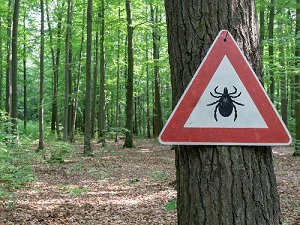When the CDC has an entire page dedicated to these little guys, then avoidance is probably the best policy. If employees are working outdoors or in any area where ticks could be present, it would be a good idea to have an annual safety meeting on how to work safely.

Often overlooked, injuries and deaths due to bees, spiders, and other insects are a concern that companies should manage as seriously as any other hazard in the workplace. Fatal on-the-job injuries do occur as a result of bites and stings from insects and spiders.
If employees are working outdoors or in any area where ants, insects, bees, wasps, ticks or spiders could be present, it would be a good idea to have an annual safety meeting on insects, bees & spiders. Topics should include how to recognize and avoid potential areas where insects may be lurking, what clothing is best to wear in the working environment, reminders to keep work areas clean and basic first aid tips if any employee is bitten or stung.
OSHA Standard 1926.21(b)(4) says that in job site areas where harmful plants or animals are present, employees who may be exposed shall be instructed regarding the potential hazards, and how to avoid injury, and the first aid procedures to be used in the event of injury.
When employers think of safety meeting topic idea, they don't often consider having a safety meeting about ticks. But at least once a year, if employees are working in environments where they could be exposed to ticks while on the job, it would be a good idea to go over these important points with the team.
- Inspect your work area before starting for signs of insects, including ticks.
- Wear light-colored, smooth-finished clothing to cover as much of the body as possible.
- Make it a habit to keep work areas clean.
- Workers outdoors may be exposed to diseases spread from the bites of infected ticks.
- Ticks may carry bacteria, parasites or viruses, including Lyme disease.
- Ticks may be found in wooded areas, high grass, or thick brush.
- Ticks are seen during the spring, summer and fall, but in warmer areas they can be active year-round.
- Check skin and clothing for ticks daily.
- If bitten but a tick, it should be removed as soon as possible.
- To remove a tick, follow these steps: 1) using tweezers grasp the tick firmly, as close to your skin as possible, 2) pull the tick's body away from your skin with a steady motion, and 3) clean the area with soap and water.
- If any insect bite causes severe chest pain, nausea, severe sweating, loss of breath, serious swelling, or slurred speech, seek immediate medical attention.
Learn more at http://www.cdc.gov/ticks/
The National Alliance of Safe Pest Control has great guides and resources at pests.org to learn more about specific aspects of pests and the threat they present, including common tick-borne diseases that you should be sure to protect yourself against while on the job.
If ticks are a concern for you and your family, consider adding plants that repel ticks to your home environment, both indoors and outdoors.
.jpeg)

.jpg)